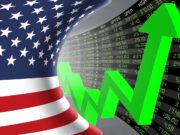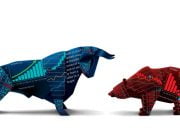The stock sell-off accelerated last week after first-quarter reports from retail giants Walmart and Target rattled markets. The key retailers reported operating margin misses driven by higher input costs from areas like fuel and freight. Inflation concerns were driven by the disappointing earnings, adding fuel to market-wide losses for the week. The Dow contracted 2.9%, the Nasdaq fell 3.8%, and the S&P 500 finished the week 3% lower after briefly dropping into bear market territory, 20% below its January ATH.
Ongoing supply-chain issues, elevated inflationary pressures, and Fed aggressiveness have driven recession fears in recent weeks. However, according to Bloomberg, with the S&P 500 now down close to 18% below its record high, equity markets have priced in a 75% chance of recession.
This week investors will be looking for clues about monetary policy and inflation. On Wednesday, the Federal Reserve is scheduled to release minutes from its May meeting, and on Friday, an update for the Fed’s preferred gauge for tracking inflation, the Personal Consumption Expenditures Price Index, is slated for release.
Our team has three recommendations with the current backdrop in mind, including a strategy you may not have considered for hedging against interest rate hikes and a ticker that could be set to soar with renewed support from Beijing.
One of the single best ways to hedge against rising interest rates is through insurance companies. The reason being that insurance companies invest heavily in fixed-income assets like corporate and government bonds. As interest rates rise, insurers earn a higher yield, and profits rise. American International Group (AIG) is one of the well-positioned companies in the group.
Making the stock even more attractive – it seems like a bargain at current levels compared to peers. AIG is currently trading at less than 6 times forward earnings, cheap compared to top competitor Cigna Corp. (CI), which trades at more than 17 times forward earnings. Further, the company’s price to book ratio of 0.74 is attractive compared to the insurance industry, where the average price to book ratio is more than twice that at 1.65.
The 13 analysts offering a 12-month price forecast for AIG have a median target of $69.50, representing a 25% increase from Friday’s closing price. The stock comes with a 2% dividend backed by a sustainable 12% payout ratio.
Fears are growing that the Fed’s aggressiveness will strain a vulnerable economy and that the Fed’s attempt to beat inflation could inadvertently push the economy into a recession.
“A recession at this stage is almost inevitable,” said former Fed vice chair Roger Ferguson. “It’s a witch’s brew, and the probability of a recession I think is unfortunately very, very high because the Fed’s tool is crude, and all they can control is aggregate demand.”
The big question now is – how do you protect your portfolio from what’s coming? Global X Adaptive U.S. Risk Management ETF (ONOF) is the risk-on/risk-off strategy that the pros on Wall Street use when they want to benefit from movement in both stocks and treasuries.
ONOF is a passively-managed portfolio that provides exposure to the S&P 500 when conditions look more favorable but rotates into short-term (1-3 year) Treasuries when market conditions look bad.
The methodology for this fund is a little more complicated than what you find in the typical ETF. The idea is that it looks at various technical indicators to make an allocation decision. The index is based on historical data from two short-term indicators: Moving Average Convergence Divergence (MACD) and the level of the CBOE Volatility Index (VIX), as well as two long-term indicators: 200-day Simple Moving Average (SMA) and market drawdown percentage.
The trigger threshold for each signal is based on a predetermined Z-score. If the portfolio is in equities, it takes three negative indicators to switch the exposure to Treasuries. Once in Treasuries, it takes two positive indicators to switch to equities, thus, creating a higher hurdle to get out of the market than it is to enter. Based on the strategy, turnover in the portfolio should be higher than a buy-and-hold approach.
During a meeting last Tuesday with China’s most significant tech CEOs, China’s Vice Premier said that Beijing would encourage the further development of digital platforms and that regulators would try to “properly manage” the relationship between the government and the market. China’s Vice Premier also said that Beijing would support more public listings of China’s tech companies, both domestically and overseas.
If the worst of the regulatory pressure is in the rearview, it may be time to start looking at the best Chinese stocks that have had their prices slashed in recent months.
Founded in 2015, Pinduoduo (PDD) is one of the fastest-growing tech companies in the world. The agriculture-focused e-commerce platform connects more than 12 million farmers with distributors and consumers directly through its interactive shopping experience, allowing users to participate in group buying deals.
In 2017, the company ended its online direct sales model and transitioned to purely providing online marketplace services to third-party merchants across more categories. According to Pinduoduo‘s July 2018 prospectus, this change from a first party to a third party marked the start of explosive growth. From there, Duo Duo Live was launched in December 2019 as a live streaming feature available for merchants to better promote their wares. Duo Duo Grocery, a next-day, click-and-collect grocery service, was rolled out in August 2020 as a response to the changing consumer needs for buying groceries in the wake of the COVID-19 pandemic.
Since its Feb 2021 peak, PDD’s share price is down more than 80%. The stock garners a solid Buy rating from the Wall Street pros offering recommendations and a median price target of $46, representing a 98% increase from Friday’s closing price.
Should you invest in Pinduoduo right now?
Before you consider buying Pinduoduo, you'll want to see this.
Investing legend, Keith Kohl just revealed his #1 stock for 2022...
And it's not Pinduoduo.
Jeff Bezos, Peter Thiel, and the Rockefellers are betting a colossal nine figures on this tiny company that trades publicly for $5.
Keith say’s he thinks investors will be able to turn a small $50 stake into $150,000.
Find that to be extraordinary?
Click here to watch his presentation, and decide for yourself...
But you have to act now, because a catalyst coming in a few weeks is set to take this company mainstream... And by then, it could be too late.
Click here to find out the name and ticker of Keith's #1 pick...







